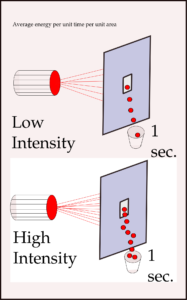Table of Contents
The amount of energy carried by a wave per unit time across a unit area’s surface is referred to as intensity. It’s also the same as the sum of energy density and wave speed. We usually use watts per square metre as a unit of measurement. The strength and amplitude of a wave under propagation will determine the magnitude of intensity. The letter I stands for Intensity. Acoustic intensity is a term that is occasionally used to describe sound intensity. It is calculated as the power conveyed by sound waves per unit area in a perpendicular direction to that region. The watt per square metre is the SI unit of intensity, i.e. sound intensity. One sound’s intensity can be compared to the intensity of another sound source with the same frequency. It is possible to do so by calculating the power value ratio of these. When this ratio is ten, the difference in sound intensity is measured as one bel.

The intensity of a wave is the amount of energy it conveys per unit time across a unit area of surface, and it is also equal to the energy density multiplied by the wave speed. It is typically measured in watts per square metre. The intensity of a wave is determined by its strength and amplitude. The letter I stands for intensity. The intensity formula is articulated by,
Where I denotes intensity, P denotes power, and A denotes cross-sectional area.
A sound wave’s intensity is determined by the rate and density of energy transfer. It is a quantifiable quantity associated with a wave. The perceptual response to the physical property of intensity is loudness. It is a more complex subjective quality associated with a wave. In general, the greater the amplitude, the greater the intensity, and thus the louder the sound. The term “loud” refers to sound waves with large amplitudes. The term “quiet” or “soft” refers to sound waves with small amplitudes. The word “low” can also be used to mean “quiet,” but this should be avoided. To describe sounds with a low frequency, use the word “low.”
Dimensional Formula of Intensity
Intensity’s dimensional formula is given by,
[M1 L0 T-3]Where M stands for mass.
T = Time L = Length
Intensity (I) = Power × [Area]-1 . . . . . (1)
The area dimensional formula = [M0 L2 T0] . . . . (2)
Power = Work × [Time]-1 . . . . (3)
Work = Force × Displacement = M × a × Displacement
⇒ Work = [M] × [M0 L1 T-2] × [L]
the work dimensional formula = [M1 L2 T-2] . . . . (4)
When we substitute equation (4) into equation (3), we get
Power = [M1 L2 T-2] × [M0 L0 T1]-1
the power dimensional formula = [M1 L2 T-3] . . . . (5)
When we substitute equations (2) and (5) into equation (1), we get
Intensity (I) = Power × [Area]-1
Or, I = [M1 L2 T-3] × [M0 L2 T0]-1 = [M1 L0 T-3]
As a result, the time period is represented dimensionally as [M1 L0 T-3].
FAQs
In physics, what is the intensity of light?
The term intensity refers to the rate at which light spreads over a given surface at a given distance from a source. The intensity varies with distance from the source and source power.
What exactly is the sound intensity dimension?
The sound intensity is defined as the sound power per unit area. As a result, its SI unit is W m-2.


